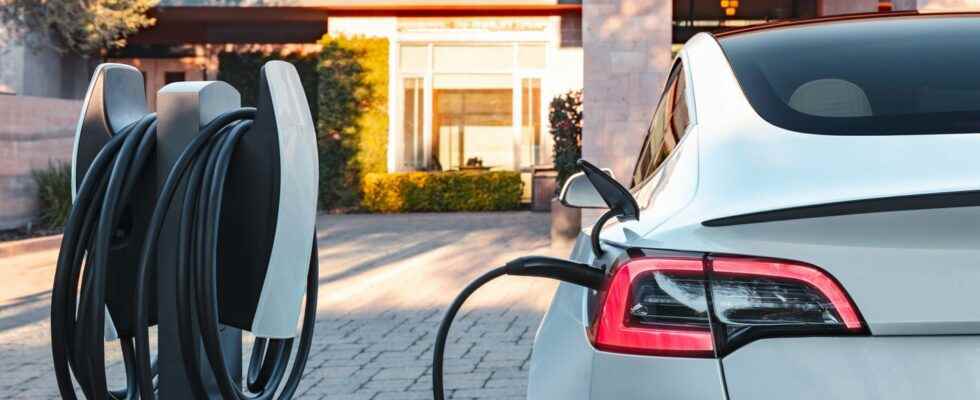Some media are suggesting that recharging an electric car will cost more than filling up a thermal car from October 1 in Great Britain. But it is false and we explain to you why.
In France, the price of electricity on the wholesale market soared to the point of reaching 1,000 euros per MWh against 85 euros a year earlier. Fortunately, we have the energy shield which protects us, at least until the end of the year, with the regulated tariff making it possible to invoice a kWh for 17 centimes. In Great Britain, the situation is much more delicate, since the cost of the kWh will go from 0.28 pounds (about 0.32 euros) to 0.52 pounds (about 0.61 euros) on average for individuals, to from October 1, 2022.
The cost of charging electric cars is skyrocketing
A huge increase (by 80%), but limited by a device similar to our energy shield. An independent company, RAC, therefore sounded the alarm by announcing that the cost of charging electric cars was going to soar. In its press release, RAC takes the example of a Kia e-Niro for which the full of electrons will go from 18.37 pounds (about 21 euros) to 33.80 pounds (about 39 euros).
Many media have rushed into the breach indicating that it will be more expensive to travel in an electric car than in a thermal car in England from next October. Some French media reported the same story. But this is false, and even RAC was forced to publish a denial on Twitter to clarify that the organization had not said that.
Thermal versus electric: we do the math
To see more clearly, we decided to take out the calculator to check the situation. We take the example of the Kia e-Niro, but also the Tesla Model 3 Propulsion. Opposite, in thermal, we take the gasoline Kia Sportage and the BMW 3 Series in the 320d diesel and 320i gasoline version.
The idea being to calculate the energy cost (in gasoline, diesel or electricity) to travel 650 km. We base ourselves on theWLTP autonomy electric cars to calculate their consumption (which therefore includes regenerative braking, unlike the WLTP consumption): 460 km for the Kia e-Niro and 510 km for the Tesla Model 3 Propulsion.

For thermal cars, we take into account their WLTP consumption. That is to say 5l / 100 km for the Kia Sportage, 5l / 100 km for the BMW 320d and 6.6l / 100 km for the BMW 318i. The cost of gasoline was noted on the site RAC on August 15, namely 1.73 pounds per liter of gasoline and 1.84 pounds per liter of diesel.
It should also be noted that we take into account the loss when recharging electric cars on an alternating current terminal, as shown by a recent German study. This is thus around 10% loss for the Kia e-Niro and 18% loss for the Tesla Model 3 Propulsion. A sort of “phantom” consumption, which is lost by the converter in heat due to the Joule effect.
Here is the result over 650 km, between two electric cars and three thermal cars, petrol and diesel.
Cost for a 650 km trip
| Car | Cost to travel 650 km (currently) | Cost to travel 650 km (from October 1) |
|---|---|---|
| Kia e Niro | €32.6 | 61 euros |
| Tesla Model 3 | €27.38 | 51 euros |
| Kia Sportage | €65.7 | – |
| BMW 320d | €70.2 | – |
| BMW 318i | €86.7 | – |
As can be seen in the table, trips in electric cars will always cost less than the same distance traveled in a thermal car. These results are however to be taken with a grain of salt, since it is a question of the consumption announced by the manufacturers, and we know that they are often higher in fact depending on the routes taken during the journey as we have seen in our Paris – Marseilles.

It does not change the result, because if all the cars in the table consume more than indicated, then all the figures will be higher and the electric ones will always cost, a priori, cheaper than thermals. The only gray area concerns highway journeysduring which the consumption of electric cars explodes and no longer makes it possible to achieve WLTP autonomy at all, while the consumption of thermal cars increases more slightly.
And on the highway, what does it look like?
As we have seen in our records on long distance electric cars, the Tesla Model 3 Propulsion consumes approximately 18.8 kWh / 100 km on the highway, or 122 kWh on a 650 km trip, which would translate into a bill of 74 euros in Great Britain after October 1st. Thus placing it between a BMW 320d and 318i. But beware, here we take into account the electricity prices of individuals, while refills on the motorway are often charged more expensive per kWh.
The same applies to the price of gasoline and diesel, which is generally more expensive at service stations located in rest areas. And that’s without taking into account a possible increase in the cost of these two fossil fuels in the coming months, since the electricity price is fixed in Great Britain until December 31, 2022.
The situation in France
In France, we can fear a big increase in the price of electricity in the coming months. We are at the moment protected by the energy shield, but this one could well be brought to disappear. However, we must be a little reassured by the figures that we see passing. When the wholesale electricity market announces a tariff of 1 MWh (i.e. 1,000 kWh) at 1,000 euros for the winter of 2023, this does not mean that the kWh will then be billed 1 euro to the private customer in one year.

Indeed, EDF produces its own energy, but must buy electricity on the wholesale market if its production (and that of alternative actors on renewable energies) is not sufficient to meet the consumption of the French. It is therefore the marginal cost that will increasei.e. the cost of the kWh that will be purchased on the wholesale market.
France’s energy bill will therefore increase, but not by 30 as we have read. Indeed, the electricity tariff is regulated by the State (the TRV) and calculated according to three variables: the cost of production per kilowatt hour, the cost of networks or infrastructures and taxes.
For example, EDF sells the MWh of nuclear production for 42 euros. It is difficult to predict the future cost, especially since it will vary according to the degree of government intervention. For Nicolas Goldberg, energy specialist, interviewed by France 24, the bill for the end customer could increase by 30 to 40% in February 2023 with the rise in regulated prices. Lucky are those who have photovoltaic panels at home!
To follow us, we invite you to download our Android and iOS application. You can read our articles, files, and watch our latest YouTube videos.


